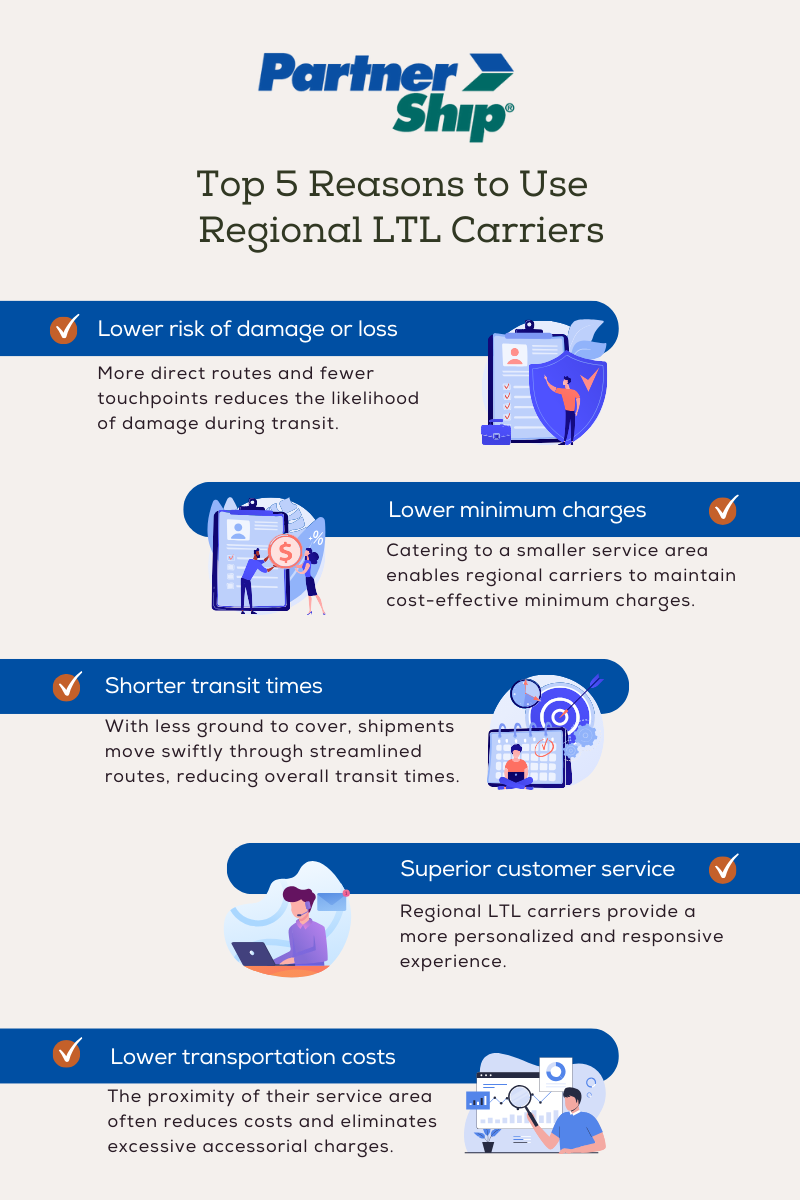October 10, 2023 at 1:57 PM
—
Leah Palnik
In the complex world of logistics, the carrier network you utilize can either optimize your shipping operations or bring them to a grinding halt. One strategy that is often overlooked is partnering with regional less-than-truckload (LTL) freight carriers. Regional LTL carriers play a crucial role in the supply chain ecosystem by offering a focused and localized approach to freight transportation. Unlike their national counterparts, regional carriers operate within specific geographic areas, so they've got the inside scoop on what makes your local logistics tick. It's like having a shipping partner who knows the shortcuts, secret spots, and best routes – because they're in your backyard.
In this article, we'll delve into the top 5 advantages of leveraging regional LTL carriers for your shipping needs and explore how they can transform your supply chain efficiency.

- Lower Damage and Loss Claims. Minimizing freight damage and loss is a top priority for any shipper. Consider regional LTL carriers as your secret weapon in the battle against damage. They excel in this aspect by offering better handling and protection of shipments. With a smaller service area, these carriers can ensure more direct routes and fewer touchpoints, reducing the likelihood of damage during transit. This commitment to careful handling translates into fewer claims and greater peace of mind for shippers.
- Lower Minimum Charges. There’s no way around it - minimum charges are a buzzkill. National carriers typically have higher minimum charges due to their extensive network coverage. Regional LTL carriers, on the other hand, offer a more favorable structure for small to medium-sized businesses. By catering to a smaller service area, these carriers can maintain cost-effective minimum charges, making them an attractive choice for shippers looking for a cost advantage.
- Shorter Transit Times through a Smaller Carrier Footprint. Efficient supply chains rely heavily on fast transit times. Regional carriers shine in this aspect as their smaller service footprint translates to quicker deliveries. With less ground to cover, shipments can move swiftly through streamlined routes, reducing overall transit times. Real-world examples have shown that regional LTL carriers consistently outperform national carriers when it comes to delivering on time.
- Top Notch Customer Service and Communication. Who doesn't love getting the VIP treatment? Customer service plays a pivotal role in freight shipping, where timely updates and proactive support are crucial. Regional LTL carriers excel in this domain by providing a more personalized and responsive customer experience. You can establish direct lines of communication with local carrier representatives who possess an in-depth understanding of the regional landscape, ensuring effective troubleshooting and issue resolution.
- Cost-Effective Shipping Solutions. For businesses that frequently ship within a specific geographic area, regional LTL carriers offer budget-friendly solutions. The proximity of the carrier's service area to the shipper's location means reduced transportation costs and potentially fewer accessorial charges. Say goodbye to excessive charges, and hello to optimizing your freight spend.

The Regional LTL Carrier Advantage is Clear
It’s clear - using regional LTL carriers puts you on track to shipping smarter. From minimizing damage to providing faster transit times and superior customer service, these carriers are tailor-made for businesses seeking localized, cost-effective, and efficient freight transportation. As you evaluate your shipping options, consider the strategic benefits that regional LTL carriers bring to the table. By making the right carrier selection, you can optimize your supply chain and elevate your shipping strategy. PartnerShip has a vast network of reputable carriers, including regional LTL freight carriers that service your area.
Contact our team today to uncover how you can benefit from utilizing regional carriers.